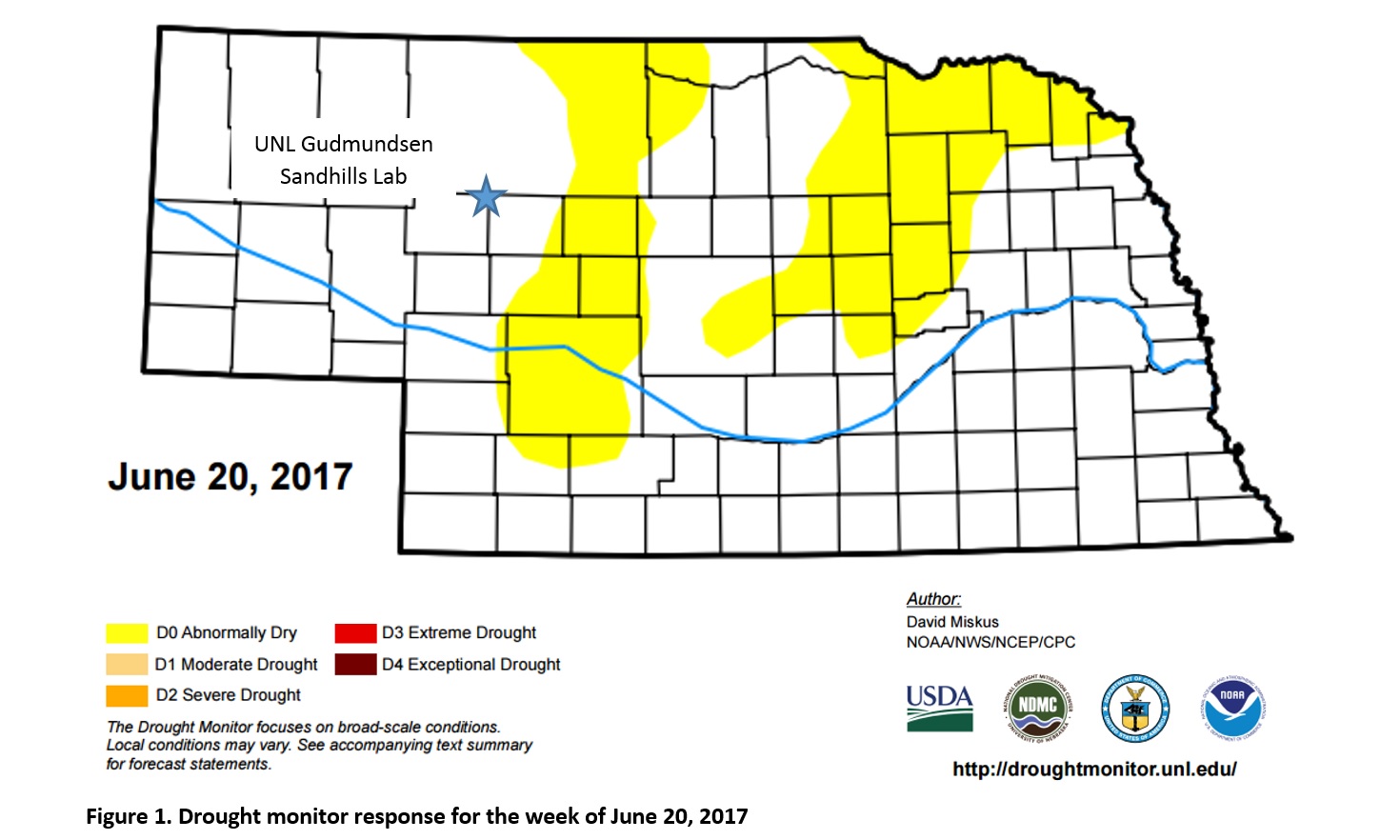
By Mitch Stephenson, Nebraska Extension Range Specialist
Recent changes in the UNL Drought Monitor reflect what many producers in the central Sandhills have begun to see on their rangelands (See Fig. 1 http://go.unl.edu/r4rt). While most areas in Nebraska are not seeing the moderate to severe drought conditions that our neighbors in the Dakotas are experiencing, the threat of drought is still concerning for Nebraska when looking at the predictions for above average temperatures for the rest of the growing season (Climate Prediction Center, http://www.cpc.noaa.gov).
IMPORTANCE OF SPRING PRECIPITATION
Spring precipitation plays a crucial role in determining the amount of forage produced in many areas of Nebraska. Precipitation in the early spring at the UNL Gudmundsen Sandhills Lab (GSL) near Whitman Nebraska was near the long-term average, but conditions have become drier with precipitation in June at only 0.2 inches (See Fig. 2 http://go.unl.edu/swyd). Average June precipitation for this area is about 3.7 inches.
Because of the abundance of warm-season grasses we see in the Sandhills, early summer precipitation plays an important role in the determining the amount of forage that is produced. Most warm-season species are just beginning their growth in the middle part of June and, unless we see some precipitation in the next few weeks, we may need to think about options for conserving available forage or finding other forage options for later in the summer. If dry conditions persist into July, grasses will usually not respond with a high degree of growth, even if we get precipitation later in the summer.
DROUGHT OF 2012
The dry conditions in 2012 are still a recent memory (See Fig. 2 http://go.unl.edu/swyd). In that year, precipitation was below average from May to the end of the year. In most areas of the Sandhills, production on warm-season grasses was well below what was typical. Production of warm-season grasses in 2012 at GSL were only 63% of the average production.
The dry conditions in 2012 also had a residual negative influence on the production of grasses during the following year. The production of grass in 2013 was only half of the longer-term average even with precipitation that was close to normal in that year. Warm-season grass production at GSL has steadily increased every year since the drought in 2012 to levels closer to the longer-term average.
It is important to include a multi-year recovery strategy in a drought plan to ensure that rangelands are given opportunities to recover to pre-drought levels. The combination of heavy grazing pressure and drought is one of the main causes of rangeland degradation. Drought is unavoidable, but management of grazing may help reduce the negative effects to desirable species composition and forage production.
“Everybody has a plan until they get punched in the mouth.”
This was the reported response from heavyweight boxer Mike Tyson when asked about his plans for an upcoming fight. Planning for drought can feel the same when the drought actually hits and some of the best-laid plans fall apart. However, having trigger dates, contingency plans, or reserve forage resources can lessen the blow of the drought.
Trigger dates are predetermined times of the year when decisions should be made for drought management. With the dry conditions in June, July 1 may be a good date to start deciding if contingency plans should be employed if no new precipitation is gained.
Contingency plans that are often used include reducing cattle numbers by selling cull or extra cattle, planning to early wean, or finding extra forage or feed resource. Selling cattle is a difficult option, but it is one of the most direct ways to relieve heavy grazing pressure from drought stricken pastures. Early weaning will reduce the feed intake requirements of the cow and help in reducing the forage demand of the cow herd. Feeding hay may not be a long-term solution to drought in all situations, but with current prices of hay or distillers grains in Nebraska, there may be options to dry lot some cattle for a period to keep cattle on the ranch and not have to truck cattle to find forage. Lastly, having some forage as a drought reserve every year can help provide greater management options when droughts occur.
The University of Nebraska has many resources available for drought management information. For more information, please see the website below or contact your local UNL Extension office.
1. Managing drought risk on the ranch – http://drought.unl.edu/ranchplan
2. UNL drought resources for livestock - http://droughtresources.unl.edu/beef2
3. U.S. Drought Monitor - http://droughtmonitor.unl.edu
4. Trigger dates and stocking rates – http://news.unl.edu/newsrooms/beef/article/trigger-dates-and-stocking-rates-drought-mitigation-cornerstones/
5. Summer pasture rental rates on a price per ton basis consumed by the cow-calf pair - http://newsroom.unl.edu/announce/beef/6418/36729
6. Management considerations for beef cows in confinement - http://extensionpublications.unl.edu/assets/pdf/g2237.pdf
To listen to BeefWatch podcasts go to: https://itunes.apple.com/us/podcast/unl-beefwatch/id964198047 or paste http://feeds.feedburner.com/unlbeefwatch into your podcast app.